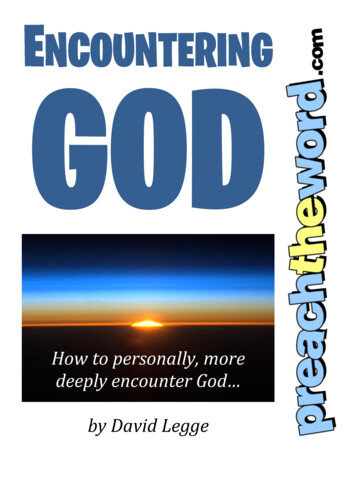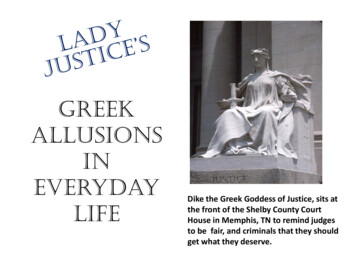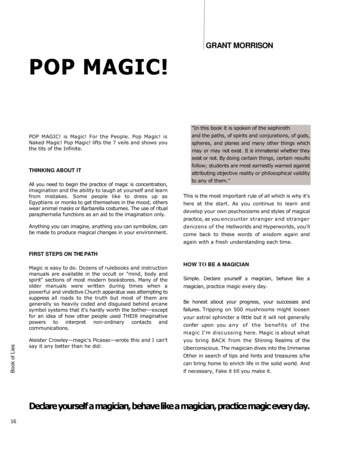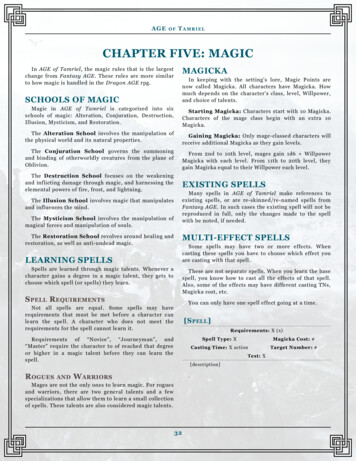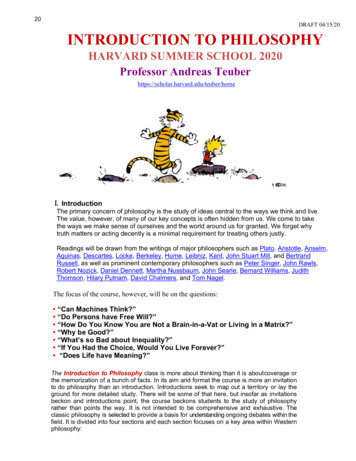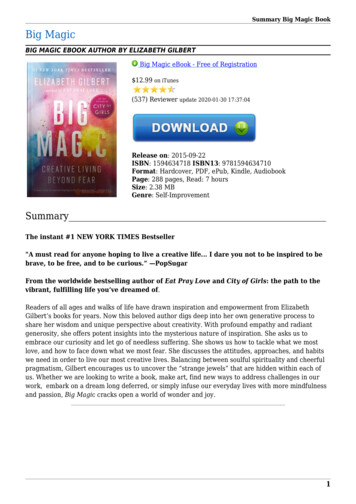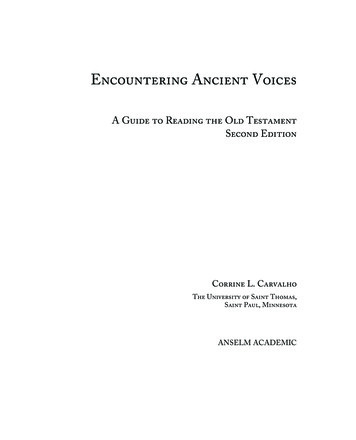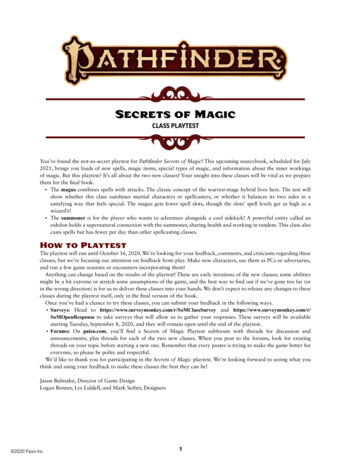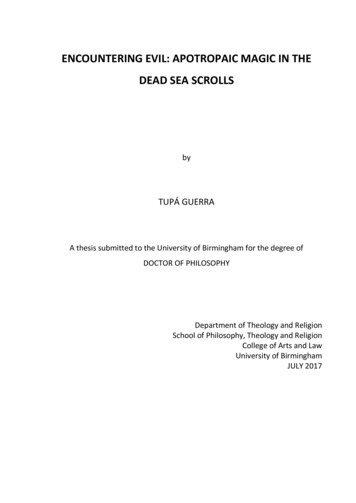
Transcription
ENCOUNTERING EVIL: APOTROPAIC MAGIC IN THEDEAD SEA SCROLLSbyTUPÁ GUERRAA thesis submitted to the University of Birmingham for the degree ofDOCTOR OF PHILOSOPHYDepartment of Theology and ReligionSchool of Philosophy, Theology and ReligionCollege of Arts and LawUniversity of BirminghamJULY 2017
University of Birmingham Research Archivee-theses repositoryThis unpublished thesis/dissertation is copyright of the author and/or thirdparties. The intellectual property rights of the author or third parties in respectof this work are as defined by The Copyright Designs and Patents Act 1988 oras modified by any successor legislation.Any use made of information contained in this thesis/dissertation must be inaccordance with that legislation and must be properly acknowledged. Furtherdistribution or reproduction in any format is prohibited without the permissionof the copyright holder.
AbstractThis thesis critically examines apotropaic magical texts from the Dead Sea Scrolls found atand near Qumran. It focuses on the danger of an encounter with and ways of protectionagainst evil beings. Magic is employed as a scholarly description for a series of accounts ofactivities that are conceived of and probably performed with the purpose of altering realityby protecting an individual or a group of people. Seven texts will be analysed, namely:Apocryphal Psalms-11Q11; 4QExorcism ar-4Q560; Songs of the Sagea-4Q510; Songs of theSageb-4Q511; 8QHymn- 8Q5; 6QpapHymn- 6Q18; and 4QIncantation- 4Q444. Themethodology focuses on a separation between active and other agents, placing action andperformance at the centre of the research. This perspective reveals a richer and morecomplex picture than the dominance of a small number of personalized figures suggested bythe texts from Cave 1 and earlier scholarship. The range of evil beings reflected in the fullcorpus attests multiple phenomena, emerging from an array of miscellaneous traditions. Theidea of fear and an atmosphere of constant threat of an encounter with the malevolentinfluence of evil figures emerges as a prominent feature in the selected texts.I
AcknowledgmentI would like to thank my supervisor Prof. Charlotte Hempel for all her guidance, advice andfriendship in this process.The support of Coordenação de Aperfeiçoamento de Pessoal de Nível Superior, CAPES, Brazilin the form of the joint PhD scholarship with the University of Birmingham is gratefullyacknowledged.I would also like to thank Prof. Dr. Vicente Dobroruka for his support during my undergraduateand masters.In a more personal note I would like to thank my mother Cida Guerra for her patience and herunconditional support in all my life’s projects. I would also like to thank my friends, in Englandand in Brazil, who were a fundamental support on this journey.II
ContentsAbstract . IAcknowledgment . IIContents . IIIAbbreviations Including Frequently Cited Sources . VII1 Introduction . 11.1 Demons . 2231.2Sectarian, Qumran and other Designations . 71.3Defining magic . 81.4History of Research . 12Format and Method. 172.1 The selection of texts and questions of genre . 182.2Active Agents . 222.3Other Agents . 222.4Means for Fending off Danger . 222.5Profile of Key Texts . 23Key Texts . 243.1 Apocryphal Psalms: 11Q11 . 253.1.13.1.23.2Physical Description . 25Classification and Order of the Fragments . 264QExorcism ar: 4Q560 . 293.2.13.2.23.3Physical Description of the Manuscript . 29Classification and Order of the Fragments . 304QSongs of the Maskila: 4Q510 . 303.3.13.3.23.4Physical Description of the Manuscript . 31Classification and Order of the Fragments . 324QSongs of the Maskilb: 4Q511 . 333.4.13.4.23.5Physical Description of the Manuscript . 33Classification and Order of the Fragments . 348QHymn (8Q5) . 373.5.13.5.23.6Physical Description of the Manuscript . 37Classification and Order of the Fragments . 374QIncantation 4Q444. 383.6.13.6.23.7Physical Description of the Manuscript . 38Classification and Order of the Fragments . 396QpapHymn (6Q18) . 403.7.13.7.23.8Physical Description of the Manuscript . 40Classification and Order of the Fragments . 40Conclusion . 404Active Agents . 43III
4.1Benevolent Agents . 444.1.14.1.24.1.34.1.44.1.54.2Alternative designations for angels . 45Righteous agents . 48Angels and humans . 50The upright . 56The maskil . 58God . 634.3Satan, Belial, Lilith, Mastema . 674.3.14.3.24.3.34.4Lilith . 67Belial and Satan . 67Mastema . 73Destroyer . 744.5Ruaḥ . ts of Understanding and Knowledge . 76Spirits of the Destroying Angels . 79Spirits of Wickedness. 80Spirit of Impurity. 82Spirits of Vanity. 83Spirits of Dispute . 84Direct Address to a Spirit . 85Very fragmentary evidence . 86Dread and Terror . 884.7Those Who Fall Upon Men without Warning . 924.8Animal references . 954.9Demons . 1024.10 Diseases. 1054.11 Creative Evil Forces . 1164.12 Single-minded Devotion to Darkness . 1184.13 Miscellaneous references . 1204.14 Conclusion . 1215Other Agents . 1265.1 Sons of. 1265.1.15.1.25.1.35.1.45.2Light . 127Belial . 130Injustice . 131Very Fragmentary Evidence. 132Israel . 1325.3Assemblies and Groups. 1355.3.15.3.2Council . 135Nation . 137IV
5.4Wicked . 1385.5Bastards. 1395.6The Befallen . 1455.7“Niedrigkeitsdoxologie” . 1475.8Power Structures . 1485.9Destruction/Suffering of Evil Beings . 1515.10 Miscellaneous references . 1535.11 Conclusion . 1556Means for Fending off Danger . 1586.1 Liturgical and Formulaic Elements . 1586.1.16.1.26.1.36.1.46.1.56.2Blessings . 159Curses . 162Adjuring . 167Amen Amen . 168The Use of Names of Known Figures . 171Musical Actions . 1746.2.16.2.26.2.36.3Praise . 177Psalms . 181Lyre . 187Weaponized Elements . 1896.3.16.3.26.3.36.3.46.4Fear . 189Statutes of God . 194Knowledge . 196Sword . 199Conclusion . 1997Profile of the Key texts . 2037.1 Apocryphal Psalms: 11Q11 . 2037.1.17.1.27.1.37.2Active Agents . 203Other Agents. 205Other particularities . 2064QExorcism ar: 4Q560 . 2087.2.17.2.27.3Active Agents . 208Other Agents. 2094QSongs of the Maskila: 4Q510 . 2107.3.17.3.27.3.37.4Active Agents . 210Other Agents. 211Other Particularities . 2124QSongs of the Maskilb: 4Q511 . 2127.4.17.4.2Active Agents . 212Other Particularities . 214V
7.58QHymn (8Q5) . 2167.5.17.6Active Agents . 2164QIncantation 4Q444. 2177.6.17.6.27.6.37.7Active Agents . 218Other Agents. 220Other Particularities . 2206QpapHymn (6Q18) . 2217.7.17.7.27.7.37.8Active Agents . 221Other Agents. 222Other particularities . 223Conclusion . 2258Conclusion . 2318.1 Questions of Terminology. 2318.2Methodological Approach . 2328.3Profile of the Corpus . 2328.4Active Agents . 2328.4.18.4.28.5Benevolent Active Beings . 233Malevolent Active Beings . 235Other Beings . 2398.5.18.5.28.6Other Benevolent Beings . 239Other Malevolent Beings . 241Means for Fending Off Danger . 2438.6.18.6.28.6.38.7Liturgical and Formulaic Elements . 244Musical Actions . 245Weaponized Elements . 246General Aspects . 247Bibliography . 252VI
Abbreviations Including Frequently Cited SourcesANESSupAncient Near Eastern Studies Supplement SeriesBDBBrown, F., S. Driver, and C. Briggs, eds. The Brown-Driver-Briggs Hebrew andEnglish Lexicon. Repr. Peabody, MA: Hendrickson, 1991.BJSBrown Judaic StudiesBNPBrills New Pauly: Encyclopedia of the Ancient World. Edited by Hubert Cancik.Online Edition. http://dx.doi.org/10.1163/1574-9347 bnp e309270.CBQCatholic Biblical QuaterlyCUPCambridge University PressCurBRCurrents in Biblical ResearchDJDDiscoveries in the Judaean DesertDJD 3Baillet, Maurice, Józef T. Milik, Roland de Vaux, and H. W. Baker. Les ‘PetitesGrottes’ de Qumran. DJD 3. Oxford: Clarendon Press, 1962.DJD 7Baillet, Maurice. Qumrân Grotte 4. 3 (4Q482-4Q520). DJD 7. Oxford:Clarendon Press, 1982.DJD 23García Martínez, Florentino, Eibert J. C. Tigchelaar, and Adam. S. van derWoude. Qumran Cave 11.2: 11Q2-18 and 11Q20-31. DJD 23. Oxford:Clarendon Press, 1998.DJD 29Chazon, Esther G., Torleif Elgvin, Esther Eshel, Daniel K. Falk, Bilha Nitzan,Elisha Qimron, Eileen M. Schuller, David Seely, Eibert J. C. Tigchelaar, andMoshe Weinfield. Poetical and Liturgical Texts, Part 2. DJD 29. Oxford:Clarendon Press, 1999.VII
DJD 37Puech, Émile. Textes en Araméen, deuxième partie. DJD 37. Oxford:Clarendon Press, 2008.DJD 39Tov, Emanuel, ed. Indices and an Introduction to the Discoveries in theJudaean Desert Series. DJD 39. Oxford: Clarendon Press, 2002.DSDDead Sea DiscoveriesDSSDead Sea ScrollsDSSELTov, Emanuel, ed.The Dead Sea Scrolls Electronic Library [Electronic Resource].Brigham Young University; Leiden: Brill, 2006.EDEJCollins, John J., Daniel C. Harlow, eds. The Eerdmans Dictionary of EarlyJudaism. Grand Rapids, MI: Eerdmans, 2010.EDSSSchiffman, Lawrence H. and James C. VanderKam, eds. Encyclopedia of theDead Sea Scrolls. Vol. 1-2. New York: OUP, 2000.HUCAHebrew Union College AnnualIEJIsrael Exploration JournalIsbellIsbell, Charles D. Corpus of the Aramaic Incantation Bowls. Eugene OR: Wipfand Stock, 2009.JBLJournal of Biblical LiteratureJJSJournal of Jewish StudiesJNESJournal of Near Eastern StudiesJSJJournal for the Study of Judaism in the Persian, Hellenistic and Roman PeriodsJSJSupJournal for the Study of Judaism in the Persian, Hellenistic and Roman Periods:Supplement SeriesLSTSThe Library of Second Temple StudiesVIII
ODJRBerlin, Adele and Maxine Grossman, eds. The Oxford Dictionary of the JewishReligion. 2nd ed. Oxford: OUP, 2011.OED OnlineOxford English Dictionary Online. Oxford: OUP.OUPOxford University PressRBRevue bibliqueRevQRevue de QumranTDOTBotterweck, Gerhard Johannes and Helmer Ringgren, eds. TheologicalDictionary of the Old Testament. Trans. John T. Wilis et al. Rev. ed. 8 vols.Grand Rapids: Eerdmans, 1974-2006.ThWQFabry, Heinz-Josef and Dahmen, Ulrich, eds. Theologisches Wörterbuch zu denQumrantexten. 3 vols. Stuttgart: Kohlhammer, 2011-2016.VTSupSupplements to Vetus TestamentumWUNTWissenchaftliche Untersuchungen zum Neuen TestamentIX
Chapter 11IntroductionThe Dead Sea Scrolls are one of the biggest archaeological finds of the 20th century, and thefull corpus has only recently been published. This group of over 900 texts deals with a widevariety of themes. The enormity of this discovery has not been fully realized yet, and a greatdeal of work remains to be done.One example of an underexplored field is the nature and function of a significant number oftexts that presuppose some kind of ancient Jewish magic in the Scrolls. This is true especiallywhen we look at apotropaic magic. My research examines a selection of texts from thecorpus of the Dead Sea Scrolls that attest to ideas or concepts that can be characterized asmagic with protective character directed against evil beings. In the past decade, a smallnumber of scholars have begun to explore the place of magic in ancient Jewish culture.1However, this particular strand in the corpus of the Dead Sea Scrolls has received limitedattention since the publication of the full corpus.2The panorama of evil beings in the texts from Qumran is very complex and has yet to beexplored in depth. The terms “demon” and “demonology” need to be reconsidered in thelight of the full evidence published, with particular focus on the adequacy of utilization of1Gideon Bohak, “Jewish Myth in Pagan Magic in Antiquity,” in Myths in Judaism: History, Thought, Literature,ed. Ithamar Gruenwald and Moshe Idel (Jerusalem: The Zalman Shazar Center for Jewish History, 2004), 97–122; Gideon Bohak, Ancient Jewish Magic: A History (Cambridge; New York: CUP, 2011); Gideon Bohak,“Prolegomena to the Study of the Jewish Magical Tradition,” CurBR 8.1 (2009): 107–50; Esther Eshel,“Demonology in Palestine during the Second Temple Period” (PhD, Hebrew University, 2000); Esther Eshel,“Genres of Magical Texts in the Dead Sea Scrolls,” in The Demonology of Israelite-Jewish and Early ChristianLiterature in Context of Their Environment [ Die Dämonen: Die Dämonologie der Israelitisch-jüdischen undfrühchristlichen Literatur im Kontext ihrer Umwelt], ed. Armin Lange, Hermann Lichtenberger, and K. F.Diethard Römheld (Tübingen: Mohr Siebeck, 2003), 395–415.2Bohak, “Prolegomena,” 119.1
Chapter 1the terminology in a Second Temple Period Jewish context. The major issues associated withthe subject of evil beings incorporate questions on the acceptance of magic by thecommunity behind the Scrolls, a disputed point with very different conclusions by majorscholars.3A number of scholars have already undertaken fundamental research on the subject ofdemonology in ancient Judaism and in the Scrolls in particular. Their contributions deal witha variety of aspects and texts, yet overall this is still an underexplored field. In what follows Iwill first summarize the problems with terminology when it comes to the study ofdemonology in an ancient Jewish context and how scholars treated the subject of magic anddemonology in the Dead Sea Scrolls, exploring the most substantial works published in thisfield at this moment. Then I will move to some methodological questions that are going toguide the rest of the work.1.1DemonsDemons is a particularly difficult term to work with, especially in light of the popularmeaning and signification that the word implies. The mention of the term usually brings tothe mind to a person educated in the 20th century, in an occidental system of beliefs, a figureof condensed evil, capable of possessing human bodies to act according to the demon’s willor even with the ability of convincing people to do evil things. One possible, and current,representation of a demon is a humanoid with red skin and horns. Literary fiction, films and3Eibert Tigchelaar and Hindy Najman, “A Preparatory Study of Nomenclature and Text Designation in the DeadSea Scrolls,” RevQ 26.103 (2014): 305–25; Charlotte Hempel, “Rules,” in T&T Clark Companion to the Dead SeaScrolls, ed. George J. Brooke and Charlotte Hempel (Bloomsbury T&T Clark, forthcoming); Molly M. Zahn,“Parabiblical Texts / Rewritten Scripture,” in T&T Clark Companion to the Dead Sea Scrolls, ed. George J. Brookeand Charlotte Hempel (London: Bloomsbury T&T Clark, forthcoming).2
Chapter 1comics offer plenty of examples of this type of representation in a variety of ways. Consciousof the popularity of this picture I consider it important to start this research with a discussionof terminology.Terminology is a feature that often shapes the way someone is going to look at the evidence.In the words of Bohak, “the terminology we use might pre-condition our analysis of the textsand cultures we study.”4 Knowing that the way a person looks at the evidence defines theway that this evidence is being interpreted I will start this submission with a discussion of themost appropriate term to refer to beings characterized by evil actions or intentionsdescribed in the texts from Qumran. A number of scholars have treated the term “demon”and the way that it is applied to the Dead Sea Scrolls and to Jewish texts produced beforethe first century CE. This developing part of the research exposed several issues that arisefrom current terminology applied to the sources that I am working with.The word “demon” is a problematic one, with an extensive variety of meanings over thecenturies. The term comes from the Greek word δαίμων, and its etymology is uncertain. Inthe texts from Ancient Greece demon does not refer to a single type of phenomenon. InHesiod “demon” is used for the soul of the deceased (Op. 121-126), and in philosophicaltexts, like Plato (Symp. 202d-e), demon can refer to a being that intermediates betweenGods and humans. The term was not necessarily related to evil beings, but the associationwith bad actions was common (Odyssey 4. 2073-79).4Gideon Bohak, “Review of Demons: The Demonology of Israelite-Jewish and Early Christian Literature inContext of Their Environment [ Die Dämonen: Die Dämonologie der Israelitisch-jüdischen und frühchristlichenLiteratur im Kontext ihrer Umwelt],” JSJ 37.1 (2006): 123-27, 125.3
Chapter 1In later antiquity, the Greek term daemon is extended to include concepts from othercultures, as pointed out by Petersen.5 This demonstrates how recognizing demons incultures that do not have this concept is a very old problem. Frequently demon is a categoryof beings applied to any cultural context without a discussion of whether the term isapplicable to this context.6 This can lead to a failure to appreciate the particular character ofdistinctive mythologies.Via the Greek and Roma
This thesis critically examines apotropaic magical texts from the Dead Sea Scrolls found at and near Qumran. It focuses on the danger of an encounter with and ways of protection against evil beings. Magic is employed as a scholarly description for a series of accounts of
